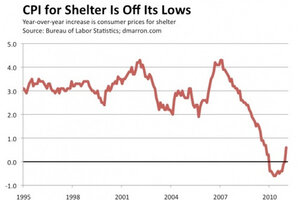How is housing affecting inflation?
Housing costs are still rising slower than the price of other core goods and services, but the gap is narrowing.

This chart shows a year-over-year increase in consumer prices for shelter from 1995 to 2010. Over the past year, shelter costs have been rising.
Donald Marron
A few months ago, I argued that housing was messing up inflation measures, in particular the core CPI. With last week’s release of fresh CPI data, I decided to check in to see if that’s still true.
Answer: Yes, but less so. The cost of housing is still rising slower than for other core goods and services, but the gap has narrowed.
In my earlier post, I found that year-over-year core inflation through October was a remarkably low 0.6% and that housing costs (as measured by the CPI for shelter) had fallen 0.4%. As a result, core inflation less shelter was 1.3% — low, but not remarkably so.
We now have data through January: core inflation has picked up a bit to 0.9% over the past 12 months. Shelter costs rose 0.6% over the same period, and core inflation less shelter is 1.2%.
As you can see, the big change is that shelter costs over the past year are now rising, not falling:
Bottom line: Housing costs have dragged the core CPI down over the past year, but not as much as was true a few months ago.
P.S. My earlier post provides details about the BLS measure of shelter prices.
Add/view comments on this post.
------------------------------
The Christian Science Monitor has assembled a diverse group of the best economy-related bloggers out there. Our guest bloggers are not employed or directed by the Monitor and the views expressed are the bloggers' own, as is responsibility for the content of their blogs. To contact us about a blogger, click here. To add or view a comment on a guest blog, please go to the blogger's own site by clicking on the link above.
